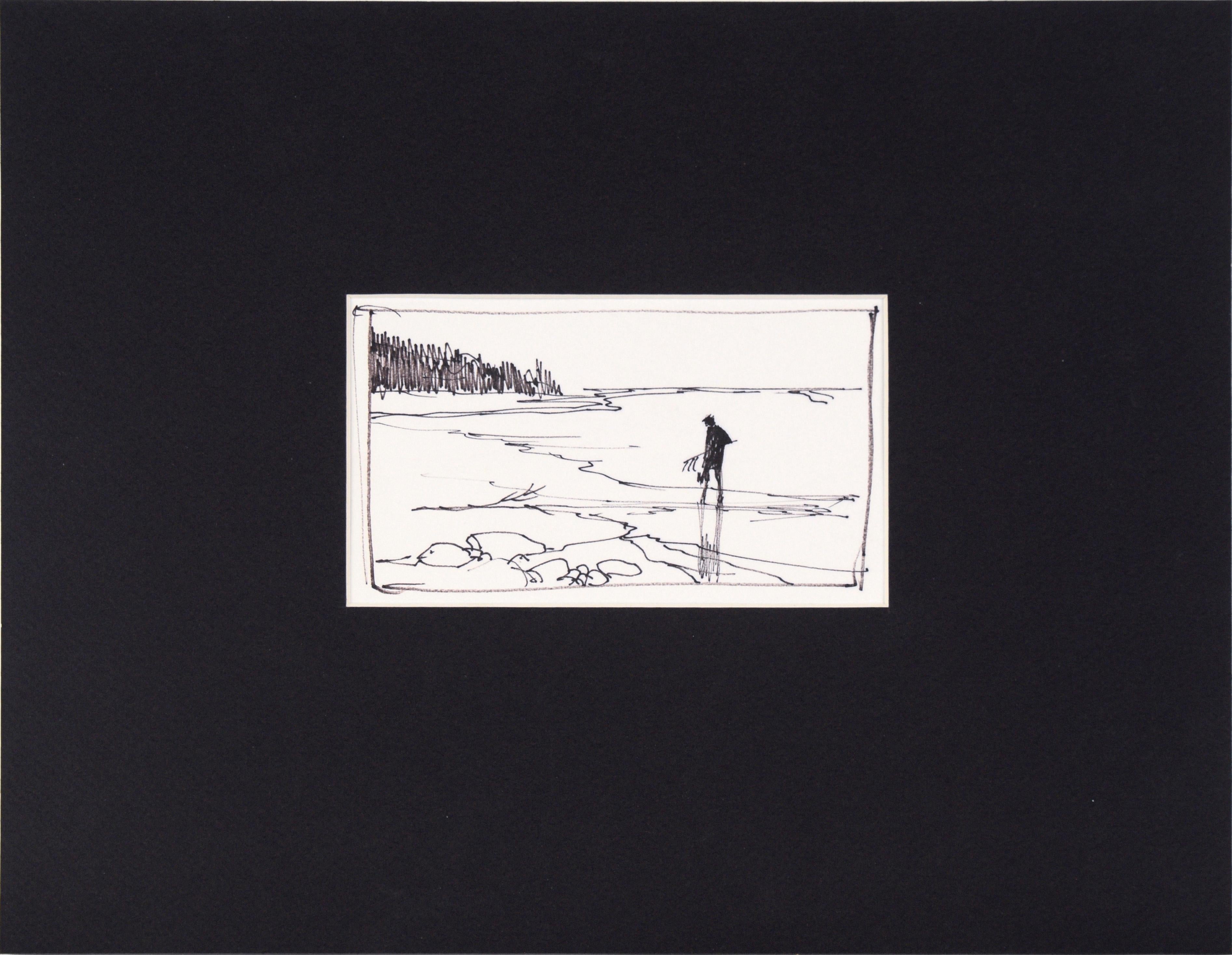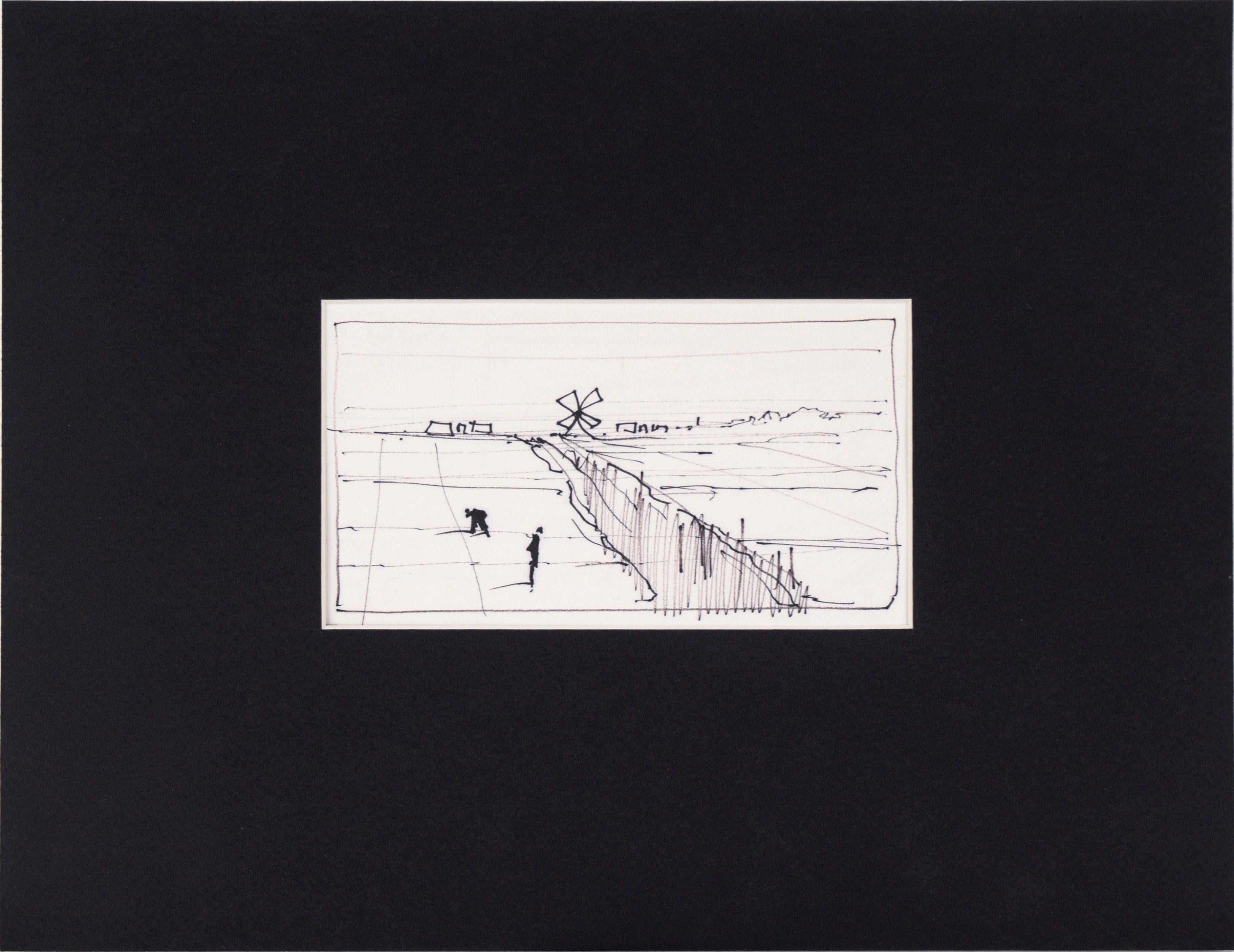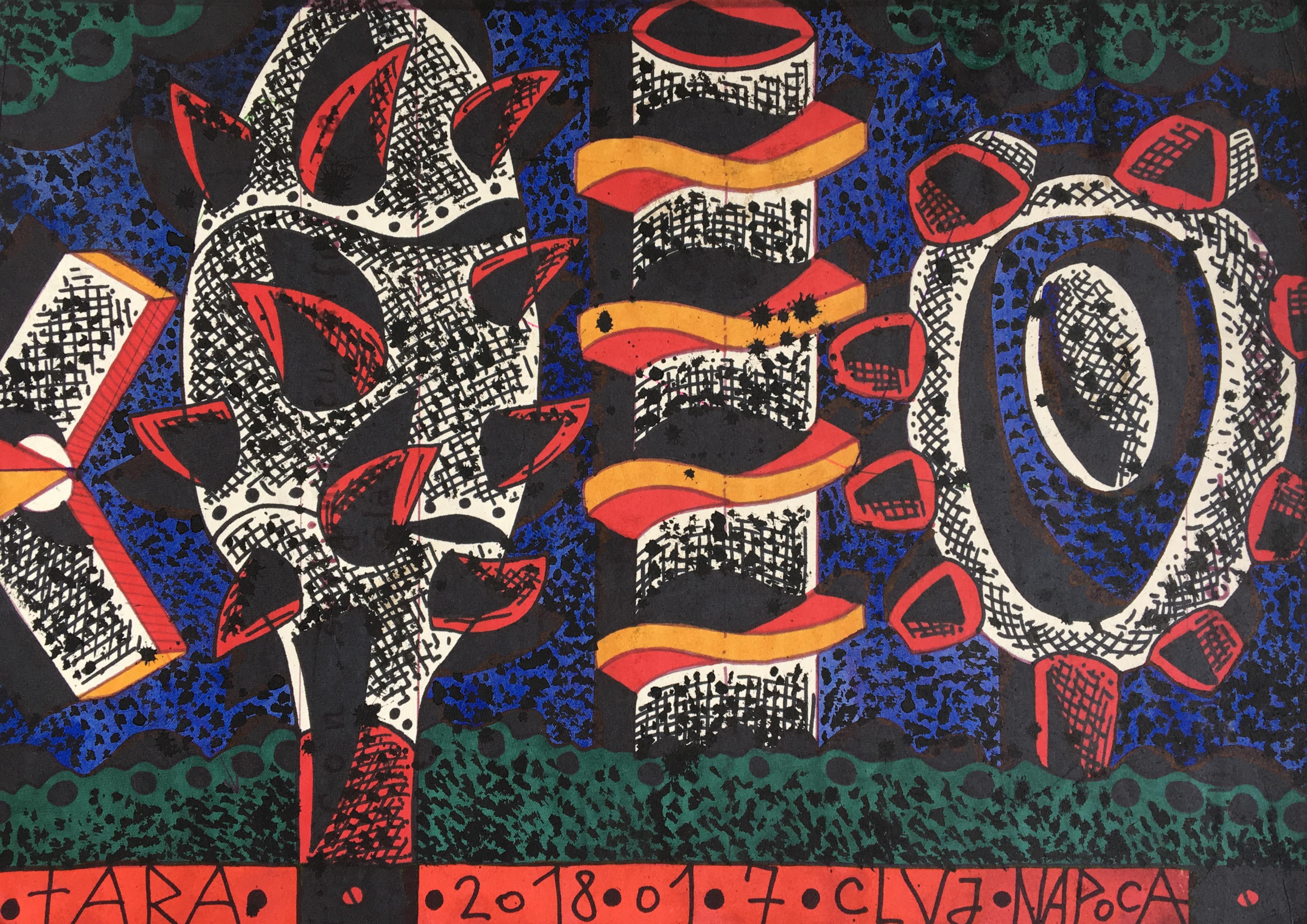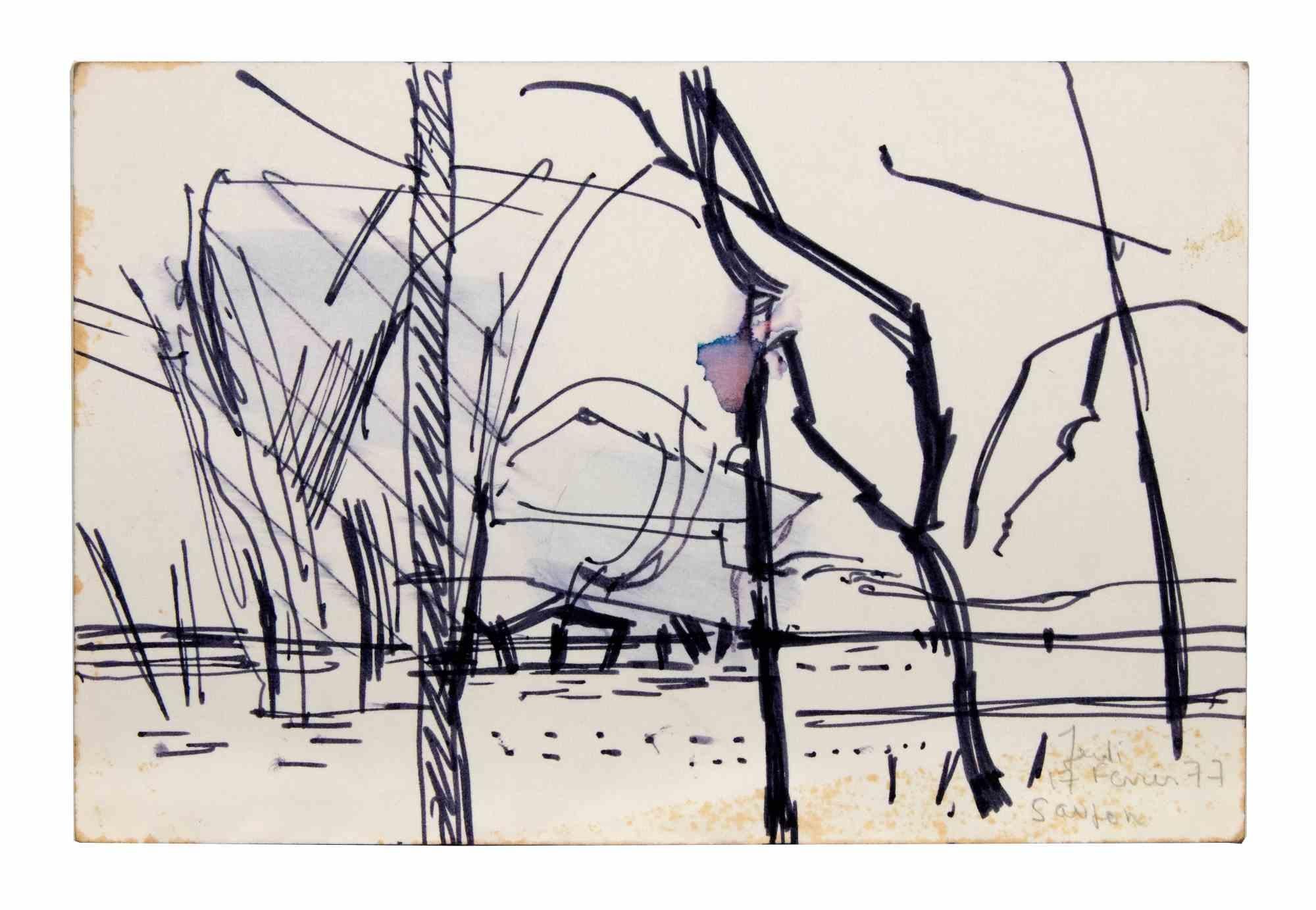Items Similar to Landscape - Black Marking Pen Drawing by G. Laurieu - 1954
Want more images or videos?
Request additional images or videos from the seller
1 of 5
Gaston LaurieuLandscape - Black Marking Pen Drawing by G. Laurieu - 19541954
1954
About the Item
Landscape is an original drawing in marking pen on cardboard realized in 1954 by Gaston Laurieu( 1908-1983).
Hand-signed and dated on the middle left with the dedication of the artist.
The State of preservation is very good.
The artwork represents a French landscape of a city with the traditional buildings, through intense black color, skillfully depicted by quick and confident strokes, the black shapes and drawing on the right resembling of the trees, demonstrates an expressionistic style of creation and the mastery of the artist in subjective attitude toward drawing of the landscape.
- Creator:Gaston Laurieu (1908 - 1983)
- Creation Year:1954
- Dimensions:Height: 12.8 in (32.5 cm)Width: 19.69 in (50 cm)Depth: 0.08 in (2 mm)
- Medium:
- Movement & Style:
- Period:
- Framing:Framing Options Available
- Condition:Insurance may be requested by customers as additional service, contact us for more information.
- Gallery Location:Roma, IT
- Reference Number:
About the Seller
4.9
Platinum Seller
These expertly vetted sellers are 1stDibs' most experienced sellers and are rated highest by our customers.
1stDibs seller since 2017
6,693 sales on 1stDibs
Typical response time: 2 hours
- ShippingRetrieving quote...Ships From: Grasse, France
- Return PolicyA return for this item may be initiated within 14 days of delivery.
More From This SellerView All
- Beach - Original Drawing in Pen by Jeanne le Soudiere - 20th CenturyLocated in Roma, ITBeach is a beautiful drawing in pen realized by the artist Jeanne le Soudiere. Hand-signed on the lower left. The state of preservation is excellent. The artwork represents a beac...Category
20th Century Naturalistic Figurative Drawings and Watercolors
MaterialsPen
- Landscape - Drawing By Reynold Arnould - 1977Located in Roma, ITLandscape is a black Marker Drawing and Watercolour realized by Reynold Arnould (Le Havre 1919 - Parigi 1980). Good condition on a little white paper. No signature, dated on the l...Category
1970s Modern Landscape Drawings and Watercolors
MaterialsWatercolor, Permanent Marker, Paper
- Le Jardin Près du Port de Catania - Drawing By Reynold Arnould - 1970Located in Roma, ITLe Jardin Près du Port de Catania is a Watercolour and Color Marker Drawing realized by Reynold Arnould (Le Havre 1919 - Parigi 1980). Good condition and vivid colors. No Signatur...Category
1970s Modern Landscape Drawings and Watercolors
MaterialsWatercolor, Permanent Marker, Paper
- Leningrad - Drawing By Reynold Arnould - 1970Located in Roma, ITLeningrad is a Color Markers Drawing and Watercolour realized by Reynold Arnould (Le Havre 1919 - Parigi 1980). Good condition on a little sheet of a notebook. No signature, date...Category
1970s Modern Figurative Drawings and Watercolors
MaterialsPermanent Marker, Paper
- Seascape - Drawing By Reynold Arnould - Mid-20th CenturyLocated in Roma, ITSeascape is a Watercolour and Color Marker Drawing realized by Reynold Arnould (Le Havre 1919 - Parigi 1980). Good condition on a sheet of notebook. No signature. Reynold Arnould...Category
Mid-20th Century Modern Landscape Drawings and Watercolors
MaterialsWatercolor, Permanent Marker, Paper
- Kiev - Drawing By Reynold Arnould - 1970Located in Roma, ITKiev is a Watercolour and Color Marker Drawing realized by Reynold Arnould (Le Havre 1919 - Parigi 1980). Good condition and vivid colors on a sheet of a notebook. No Signature, ...Category
1970s Modern Landscape Drawings and Watercolors
MaterialsPermanent Marker, Watercolor, Paper
You May Also Like
- Beachcomber with Clam Rake - Line Drawing Landscape in Ink on PaperBy Laurence SissonLocated in Soquel, CABeachcomber - Line Drawing Landscape in Ink on Paper Bold landscape line drawing by listed Maine artist Laurence Sisson (American, 1928-2015). A lone figure walks a shoreline carrying a tool towards a line of trees stretching towards the water. This drawing was likely a preparatory sketch for a larger painting. This piece is unsigned, but was acquired from David Sisson, the artist's son. Presented in a new black mat with foam-core backing. Mat size: 10"H x 13"W Image size: 4.25"H x 7.19"W Laurence Sisson, was a student of Herbert Barnett (1910-1972), he was one of America's preeminent realist painters today. His work may be found in the permanent collections of museums nationwide including the Museum of Fine Arts, Boston, and the Portland Museum of Art, Maine. Laurence Sisson painted landscapes for sixty years. He was known for his paintings of the Maine coast and landscapes of the southwest. His style ranges from plein air watercolors to large oil landscapes...Category
Late 20th Century American Impressionist Landscape Drawings and Watercolors
MaterialsPaper, Permanent Marker
- Tending the fields - Windmill - Line Drawing Landscape in Ink on PaperBy Laurence SissonLocated in Soquel, CATending the fields - Line Drawing Landscape in Ink on Paper Bold landscape line drawing by listed Maine artist Laurence Sisson (American, 1928-2015). Two figures bent over the field...Category
Late 20th Century American Impressionist Landscape Drawings and Watercolors
MaterialsPaper, Permanent Marker
- Techno-Forest - 21st Century, Trees, Figurative, Drawing, Blue, Red, OrangeBy Tara von NeudorfLocated in Berlin, DETechno-Forest, 2018 Ink and marker on paper (Signed and dated on lower front end) 11.61 H x 16.53 W in 29.5 H x 42 W cm The majority of Tara’s drawings are built on the idea of in...Category
2010s Contemporary Figurative Drawings and Watercolors
MaterialsPaper, Permanent Marker, Ink
- Transylvanian Forest - 21st Century, Trees, Drawing, Figurative, Red, GreenBy Tara von NeudorfLocated in Berlin, DETransylvanian Forest, 2018 Ink and marker on paper (Signed and dated on lower front end) 11.81 H x 16.53 W in 30 H x 42 W cm The majority of Tara’s drawings are built on the idea o...Category
2010s Contemporary Figurative Drawings and Watercolors
MaterialsInk, Paper, Permanent Marker
- Alfred Dumont (1828-1894) - Cerlier in Switzerland - 19thC Ink Landscape DrawingBy Alfred Paul Emil Etienne DumontLocated in Meinisberg, CHAlfred Paul Emil Etienne Dumont (Swiss, * 13. Juni 1828 in Baulmes; † 7th August 1894 in Geneva) Vue de Cerlier au lac de Bienne avec Île Saint-Pierre (Figures at an open fire, wit...Category
1860s Naturalistic Landscape Drawings and Watercolors
MaterialsPaper, India Ink
- Norwegian Pine Grove - The inner glow of the trees -Located in Berlin, DEThemistokles von Eckenbrecher (1842 Athens - 1921 Goslar), Norwegian pine grove, 1901. Watercolor on blue-green paper, 30 x 22 cm. Signed, dated and inscribed in his own hand "TvE. Fagermes [i.e. Fagermes]. 26.6.[19]01." - Slight crease throughout at left margin, otherwise in good condition. About the artwork Themistokles von Eckenbrecher often traveled to Norway to study the nature that fascinated him there. On June 26, 1901, near the southern Norwegian town of Fagernes, in the summer evening sun, he saw a small pine grove, which he immediately captured in a watercolor. He exposed the trees growing on a small hill in front of the background, so that the pines completely define the picture and combine to form a tense motif. The tension comes from the contrast of form and color. The trunks, growing upward, form a vertical structure that is horizontally penetrated by the spreading branches and the pine needles, which are rendered as a plane. This structural tension is further intensified by the color contrast between the brown-reddish iridescent trunks and branches and the green-toned needlework. Themistokles von Eckenbrecher, however, does not use the observed natural scene as an inspiring model for a dance of color and form that detaches itself from the motif and thus treads the path of abstracting modernism. Its inner vitality is to be brought to light and made aesthetically accessible through the work of art. It is precisely in order to depict the inner vitality of nature that von Eckenbrecher chooses the technique of watercolor, in which the individual details, such as the needles, are not meticulously worked out, but rather a flowing movement is created that unites the contrasts. The trees seem to have formed the twisted trunks out of their own inner strength as they grew, creatingthose tense lineations that the artist has put into the picture. The inner strength continues in the branches and twigs, culminating in the upward growth of the needles. At the same time, the trunks, illuminated by the setting sun, seem to glow from within, adding an almost dramatic dimension to the growing movement. Through the artwork, nature itself is revealed as art. In order to make nature visible as art in the work, von Eckenbrecher exposes the group of trees so that they are bounded from the outside by an all-encompassing contour line and merge into an areal unity that enters into a figure-ground relationship with the blue-greenish watercolor paper. The figure-ground relationship emphasizes the ornamental quality of the natural work of art, which further enforces the artwork character of the group of trees. With the presentation of Themistokles von Eckenbrecher's artistic idea and its realization, it has become clear that the present watercolor is not a study of nature in the sense of a visual note by the artist, which might then be integrated into a larger work context, but a completely independent work of art. This is why von Eckenbrecher signed the watercolor. In addition, it is marked with a place and a date, which confirms that this work of nature presented itself to him in exactly this way at this place at this time. At the same time, the date and place make it clear that the natural work of art has been transferred into the sphere of art and thus removed from the time of the place of nature. About the artist Themistocles' parents instilled a life of travel in their son, who is said to have spoken eleven languages. His father, who was interested in ancient and oriental culture, was a doctor and had married Francesca Magdalena Danelon, an Italian, daughter of the British consul in Trieste. During a stay in Athens - Gustav von Eckenbrecher was a friend of Heinrich von Schliemann and is said to have given him crucial clues as to the location of Troy - Themistokles saw the light of day in 1842. After an interlude in Berlin, where Themistokles was educated at the English-American School, the journey began again. From 1850 to 1857 the family lived in Constantinople, after which the father opened a practice in Potsdam, where Themistokles, who wanted to become a painter, was taught by the court painter Carl Gustav Wegener. In 1861 the von Eckenbrechers left Potsdam and settled in Düsseldorf. There Themistokles received two years of private tuition from Oswald Aschenbach, who greatly admired the talented young artist. After his artistic training, he undertook extensive travels, often accompanied by Prince Peter zu Sayn-Wittgenstein, which took him to northern and eastern Europe, but above all to the Middle East and even to South America. The paintings that resulted from these journeys established his artistic reputation and led to his participation in large panoramas such as the 118 x 15 metre Entry of the Mecca Caravan into Cairo, painted for the City of Hamburg in 1882. 1882 was also the start of a total of 21 study trips to Scandinavia, most of them to Norway, and the unique Norwegian landscape with its rugged fjords became a central motif in his work. Along with Anders Askevold and Adelsteen Normann...Category
Early 1900s Naturalistic Landscape Drawings and Watercolors
MaterialsWatercolor
Recently Viewed
View AllMore Ways To Browse
Vintage Markings
Vintage Building Drawing
Vintage Building Drawings
Vintage Style Pens
Gaston G
Charcoal Rubbing
Japanese Postcards Vintage
Set Of 4 Charcoal Drawings
Andre Roland Brudieux
24u Sofa
Black Horse China Ink
Vintage Carousel Drawing
Lv Watercolor
Chairs Reeves
Emmy Lou Packard
Helen Vogt
Pierre Georges Jeanniot On Sale
Walt Disney Fantasia





